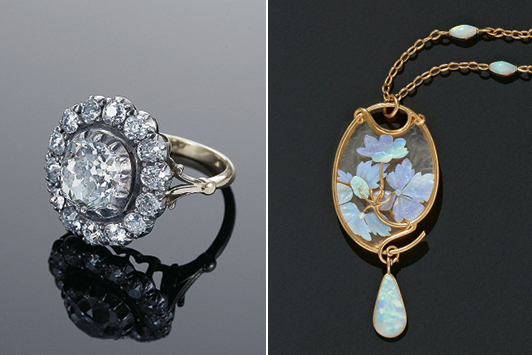 Images: Fred Leighton; Wartski, London
Images: Fred Leighton; Wartski, London
In the late 1990s, Beth Bernstein worked for a well-known antique dealer on New York’s Madison Avenue who specialized in early
period jewelry.
“Her safe was like a museum, and she would hand me books to take home and read to learn more, while I also learned from her, hands on. I met so many wonderful dealers through her,” recalls Bernstein, who has since written an extensive list of jewelry works herself. Among her books are a volume on celebrity jewels throughout the 20th century, another on emerging independent designers, and a memoir that traces jewelry’s connection to the moments in her own life.
Her latest book is
The Modern Guide to Antique Jewellery, a comprehensive compendium on collecting and enjoying these well-aged pieces. Beginning with advice on how to determine which antique jewels best suit one’s style, and ending with how to wear, care for and buy the pieces that do, Bernstein’s newest offering draws on her more than 25 years of experience in the field.
“As I continued to collect and then build a clientele of antique jewelry of my own — finding and selling pieces from the time periods covered in this book — I began writing articles on the subject and was asked to be on panel discussions [and] give guided tours through centuries of jewelry at antique shows,” she tells Rapaport Magazine. “And through it all, I continued to learn more.”
Dealers’ voices
Along with photos of beautiful jewelry, the book features anecdotes about the provenance of prized examples, as well as expert information from an array of “top-notch” dealers Bernstein knows — independent sellers and high-end stores both in America and abroad. They “truly love what they do,” she says, and “still get a thrill from finding a rare piece — and also from knowing they sold a piece to a person who would love, wear and take great pleasure in owning it.”
Rather than just her own voice, she explains, she wanted to include these dealers’ “different bits of knowledge and sometimes different takes on how they view certain periods and pieces.” Hearing varying opinions makes the book “more interactive,” she feels, and without them, “part of the story I wanted to tell would have been missing.”
Through history and beyond
Bernstein writes about her subject in a conversational rather than a scholarly tone, covering topics she describes as ranging “from defining your collecting style to how to wear a 100-year-old ring without looking dated, [and] how to mix antique and modern jewelry.”
While the chapters are arranged chronologically, “if something crosses two time periods, for example, I felt it deserved its own chapter.” And although the book doesn’t include every style from a given era, it offers a brief overview of each period’s history. “You can zoom in on any chapter at any time and read about just one time period, if that is your interest, and gain enough insight into the most popular and rare...treasures from that era.”
Like a guidebook, she says, it depicts “the most popular styles of each period that can still be found today,” as well as “how to shop an antique show [or at] flea markets, how to shop online, and how to shop at auction.”
Bernstein’s intended audience is a broad one. She hopes the book will reach “everyone who loves, collects, follows, wants to learn about or buy antique jewelry from the Georgian through early Art Deco periods.”
The Modern Guide to Antique Jewellery by Beth Bernstein will be published May 6 by ACC Art Books.
Article from the Rapaport Magazine - April 2022. To subscribe click here.